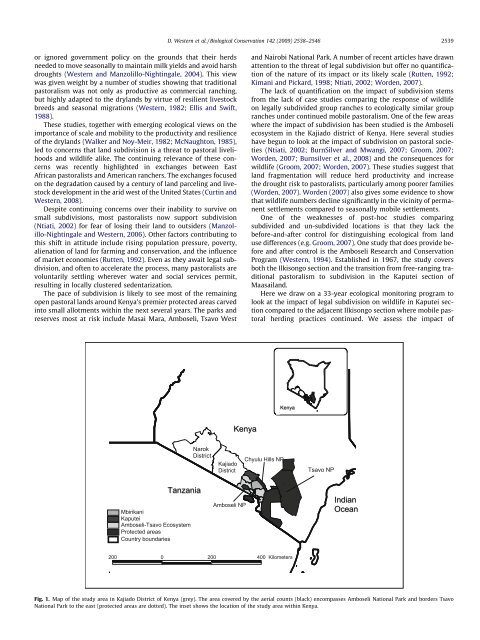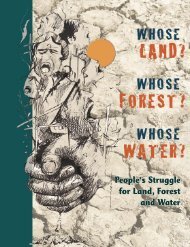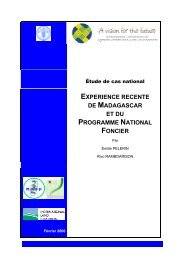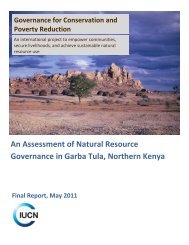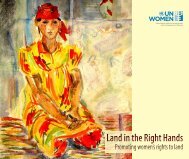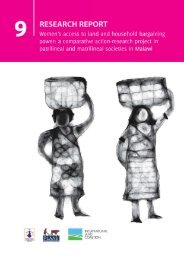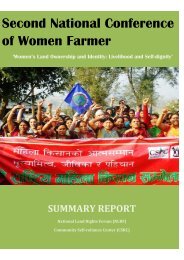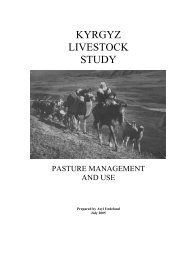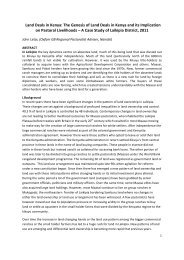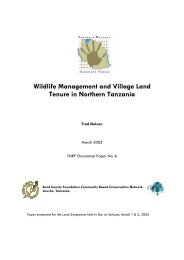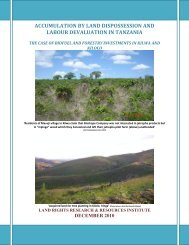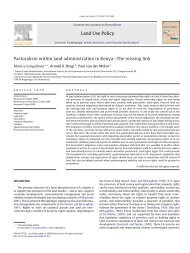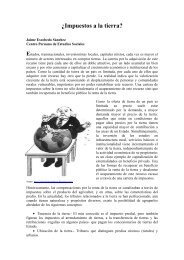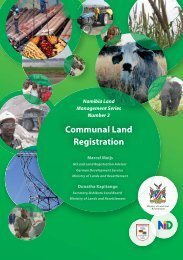The impact of subdivision and sedentarization of ... - Land Portal
The impact of subdivision and sedentarization of ... - Land Portal
The impact of subdivision and sedentarization of ... - Land Portal
You also want an ePaper? Increase the reach of your titles
YUMPU automatically turns print PDFs into web optimized ePapers that Google loves.
or ignored government policy on the grounds that their herds<br />
needed to move seasonally to maintain milk yields <strong>and</strong> avoid harsh<br />
droughts (Western <strong>and</strong> Manzolillo-Nightingale, 2004). This view<br />
was given weight by a number <strong>of</strong> studies showing that traditional<br />
pastoralism was not only as productive as commercial ranching,<br />
but highly adapted to the dryl<strong>and</strong>s by virtue <strong>of</strong> resilient livestock<br />
breeds <strong>and</strong> seasonal migrations (Western, 1982; Ellis <strong>and</strong> Swift,<br />
1988).<br />
<strong>The</strong>se studies, together with emerging ecological views on the<br />
importance <strong>of</strong> scale <strong>and</strong> mobility to the productivity <strong>and</strong> resilience<br />
<strong>of</strong> the dryl<strong>and</strong>s (Walker <strong>and</strong> Noy-Meir, 1982; McNaughton, 1985),<br />
led to concerns that l<strong>and</strong> <strong>subdivision</strong> is a threat to pastoral livelihoods<br />
<strong>and</strong> wildlife alike. <strong>The</strong> continuing relevance <strong>of</strong> these concerns<br />
was recently highlighted in exchanges between East<br />
African pastoralists <strong>and</strong> American ranchers. <strong>The</strong> exchanges focused<br />
on the degradation caused by a century <strong>of</strong> l<strong>and</strong> parceling <strong>and</strong> livestock<br />
development in the arid west <strong>of</strong> the United States (Curtin <strong>and</strong><br />
Western, 2008).<br />
Despite continuing concerns over their inability to survive on<br />
small <strong>subdivision</strong>s, most pastoralists now support <strong>subdivision</strong><br />
(Ntiati, 2002) for fear <strong>of</strong> losing their l<strong>and</strong> to outsiders (Manzolillo-Nightingale<br />
<strong>and</strong> Western, 2006). Other factors contributing to<br />
this shift in attitude include rising population pressure, poverty,<br />
alienation <strong>of</strong> l<strong>and</strong> for farming <strong>and</strong> conservation, <strong>and</strong> the influence<br />
<strong>of</strong> market economies (Rutten, 1992). Even as they await legal <strong>subdivision</strong>,<br />
<strong>and</strong> <strong>of</strong>ten to accelerate the process, many pastoralists are<br />
voluntarily settling wherever water <strong>and</strong> social services permit,<br />
resulting in locally clustered <strong>sedentarization</strong>.<br />
<strong>The</strong> pace <strong>of</strong> <strong>subdivision</strong> is likely to see most <strong>of</strong> the remaining<br />
open pastoral l<strong>and</strong>s around Kenya’s premier protected areas carved<br />
into small allotments within the next several years. <strong>The</strong> parks <strong>and</strong><br />
reserves most at risk include Masai Mara, Amboseli, Tsavo West<br />
Narok<br />
District<br />
Tanzania<br />
Mbirikani<br />
Kaputei<br />
Amboseli-Tsavo Ecosystem<br />
Protected areas<br />
Country boundaries<br />
D. Western et al. / Biological Conservation 142 (2009) 2538–2546 2539<br />
Kajiado<br />
District<br />
Kenya<br />
Amboseli NP<br />
<strong>and</strong> Nairobi National Park. A number <strong>of</strong> recent articles have drawn<br />
attention to the threat <strong>of</strong> legal <strong>subdivision</strong> but <strong>of</strong>fer no quantification<br />
<strong>of</strong> the nature <strong>of</strong> its <strong>impact</strong> or its likely scale (Rutten, 1992;<br />
Kimani <strong>and</strong> Pickard, 1998; Ntiati, 2002; Worden, 2007).<br />
<strong>The</strong> lack <strong>of</strong> quantification on the <strong>impact</strong> <strong>of</strong> <strong>subdivision</strong> stems<br />
from the lack <strong>of</strong> case studies comparing the response <strong>of</strong> wildlife<br />
on legally subdivided group ranches to ecologically similar group<br />
ranches under continued mobile pastoralism. One <strong>of</strong> the few areas<br />
where the <strong>impact</strong> <strong>of</strong> <strong>subdivision</strong> has been studied is the Amboseli<br />
ecosystem in the Kajiado district <strong>of</strong> Kenya. Here several studies<br />
have begun to look at the <strong>impact</strong> <strong>of</strong> <strong>subdivision</strong> on pastoral societies<br />
(Ntiati, 2002; BurnSilver <strong>and</strong> Mwangi, 2007; Groom, 2007;<br />
Worden, 2007; Burnsilver et al., 2008) <strong>and</strong> the consequences for<br />
wildlife (Groom, 2007; Worden, 2007). <strong>The</strong>se studies suggest that<br />
l<strong>and</strong> fragmentation will reduce herd productivity <strong>and</strong> increase<br />
the drought risk to pastoralists, particularly among poorer families<br />
(Worden, 2007). Worden (2007) also gives some evidence to show<br />
that wildlife numbers decline significantly in the vicinity <strong>of</strong> permanent<br />
settlements compared to seasonally mobile settlements.<br />
One <strong>of</strong> the weaknesses <strong>of</strong> post-hoc studies comparing<br />
subdivided <strong>and</strong> un-subdivided locations is that they lack the<br />
before-<strong>and</strong>-after control for distinguishing ecological from l<strong>and</strong><br />
use differences (e.g. Groom, 2007). One study that does provide before<br />
<strong>and</strong> after control is the Amboseli Research <strong>and</strong> Conservation<br />
Program (Western, 1994). Established in 1967, the study covers<br />
both the Ilkisongo section <strong>and</strong> the transition from free-ranging traditional<br />
pastoralism to <strong>subdivision</strong> in the Kaputei section <strong>of</strong><br />
Maasail<strong>and</strong>.<br />
Here we draw on a 33-year ecological monitoring program to<br />
look at the <strong>impact</strong> <strong>of</strong> legal <strong>subdivision</strong> on wildlife in Kaputei section<br />
compared to the adjacent Ilkisongo section where mobile pastoral<br />
herding practices continued. We assess the <strong>impact</strong> <strong>of</strong><br />
Chyulu Hills NP<br />
Kenya<br />
200 0 200 400 Kilometers<br />
Tsavo NP<br />
Indian<br />
Ocean<br />
Fig. 1. Map <strong>of</strong> the study area in Kajiado District <strong>of</strong> Kenya (grey). <strong>The</strong> area covered by the aerial counts (black) encompasses Amboseli National Park <strong>and</strong> borders Tsavo<br />
National Park to the east (protected areas are dotted). <strong>The</strong> inset shows the location <strong>of</strong> the study area within Kenya.


